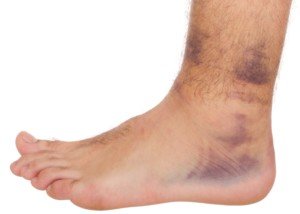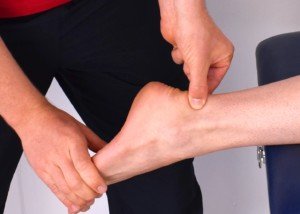
A foot pain expert describes the seven possible causes of pain on the outside (lateral) part of the foot.
Pain along the outside or lateral part of the foot can have one (or more) of six possible causes, according to Bob Thompson, certified pedorthist, executive director of the Institute for Preventive Foot Health (www.ipfh.org).
A pedorthist is a medical professional who designs devices and footwear to alleviate foot pain.
Arthritis
“There are three main joints on the lateral side of the foot – the calcaneal/cuboid, the cuboid/fifth metatarsal, and the fifth metatarsal/proximal phalange joint where the little toe begins,” says Thompson.
“In addition, closer to the center line of the foot are the cuboid/lateral cuneiform, cuboid/navicular and cuboid/fourth metatarsal joints.
“Lateral foot pain can be caused by inflammation (arthritis) in any of these.”
Cuboid Syndrome
“Where the cuboid bone articulates with the calcaneus it forms the calcaneocuboid joint,” says Thompson.
“This joint functions to lock the foot for stability on toe-off. Cuboid syndrome happens when the cuboid gets displaced or dislocated relative to the calcaneus, causing pain when walking or running.
“In cuboid syndrome the joint does not function properly, causing pain and weakness on the lateral side of the foot.”
Tendonitis
Thompson says that several major tendons run through the side of the foot. If any are inflamed, the side of your foot will hurt.
Muscle Strain
“The major muscles on the lateral side of the foot are the flexor digiti minimi and abductor digiti minimi, along with their tendons,” says Thompson.

Shutterstock/Seasontime
“Also, a larger and important tendon, that of the peroneus longus muscle, runs through the lateral side of the foot on its way to be joined to the lateral side of the first cuneiform and proximal end of the first metatarsal.”
Yes, sounds fancy, but a muscle strain indeed can cause pain along the outer side of the foot.
Fracture
“A broken bone in the foot, especially if it is one in the fifth phalanges, the fifth metatarsal or the cuboid will certainly cause lateral foot discomfort!
“The fifth metatarsal is especially prone to avulsion and Jones fractures.
“In an avulsion fracture, a small piece of bone is pulled off the main portion of the bone by a tendon or ligament.
“This type of fracture is the result of an injury in which the ankle ‘rolls’ (common among athletes).
“Avulsion fractures are often overlooked when they occur with an ankle sprain.”
Many years ago I had an avulsion fracture. I sprained my ankle playing volleyball.
In the ER the doctor said that the ligament tear took a small piece of bone with it.
I heard him behind the curtain tell somebody (presumably a nurse), “It doesn’t look good.”
I had pain on the outer side of my foot, but of course, I knew why; the pain on the outer side of my foot wasn’t a mystery. I fully recovered from this sprain.
“Jones fractures occur in a small area of the fifth metatarsal that receives less blood and is therefore more difficult to heal,” says Thompson.
“A Jones fracture can be either a stress fracture (a tiny hairline break that occurs over time) or an acute (sudden) break.
“Jones fractures are caused by overuse, repetitive stress or trauma.
“Pain, swelling, tenderness on the outside of the foot, difficulty walking and bruising may all be symptoms of these fractures.”
Ankle Sprain
I’ve had more than one ankle sprain as an athlete, and they do cause pain along the outer side of the foot.
But at least when an ankle sprain occurs, you know why you have the pain.
“Pain can radiate throughout the lateral side of the foot,” says Thompson.
 Robert Thompson is a nationally recognized speaker on the topics of preventive foot health and soft tissue injury prevention.
Robert Thompson is a nationally recognized speaker on the topics of preventive foot health and soft tissue injury prevention.
 Lorra Garrick is a former personal trainer certified through the American Council on Exercise. At Bally Total Fitness she trained women and men of all ages for fat loss, muscle building, fitness and improved health.
Lorra Garrick is a former personal trainer certified through the American Council on Exercise. At Bally Total Fitness she trained women and men of all ages for fat loss, muscle building, fitness and improved health.
.









































